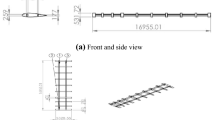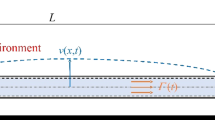Abstract
The clarification of the nonlinear and unsteady aerodynamic characteristics of a quasi-flat plate is of great importance to predict its wind-induced post-flutter behavior. Forced motion wind tunnel tests on a quasi-flat plate sectional model with a width-over-thickness ratio of 62.5:1 are conducted using the synchronous measurement of the dynamic forces and torsional displacements at various initial angles of attack (AoAs), vibration amplitudes and incoming wind speeds. The flutter derivatives related to torsional degree of freedom (DOF) are identified and compared. The nonlinear and unsteady characteristics of self-excited forces (SEFs) in terms of the frequency components and phase lag between the force and motion are quantitatively examined. The wind-induced energy maps of the quasi-flat plate at various initial AoAs are analyzed by introducing the aerodynamic work done by the self-excited lifting moment. A polynomial model is proposed to describe the nonlinear characteristics of the SEFs. It is validated that the flutter derivatives related to the torsional DOF are almost a single-valued function with respect to the reduced frequency, even at large vibration amplitudes. At large initial AoAs and oscillation amplitudes, the high-order frequency components of SEFs are significant, and the nonlinearity of the self-excited lifting moment is stronger than that of the self-excited lift force for torsional motion. This provides a reasonable explanation for the significant amplitude dependence of the flutter derivatives related to the lifting moment. The proposed polynomial nonlinear SEF model can achieve satisfactory accuracy in reproducing the SEFs in both time and frequency domains.






















Similar content being viewed by others
Availability of data and material
Some data, models that support the findings of this study are available from the corresponding author upon reasonable request.
Code availability
Some codes that support the findings of this study are available from the corresponding author upon reasonable request.
References
Fang, G.S., Pang, W.C., Zhao, L., Rawal, P., Cao, S.Y., Ge, Y.J.: Toward a refined estimation of typhoon wind hazards: parametric modeling and upstream terrain effects. J. Wind Eng. Ind. Aerodyn. 209, 104460 (2021)
Fang, G.S., Pang, W.C., Zhao, L., Cui, W., Zhu, L.D., Cao, S.Y., Ge, Y.J.: Extreme typhoon wind speed mapping for coastal region of china: geographically weighted regression-based circular subregion algorithm. J. Struct. Eng. 147(10), 04021146 (2021)
Hu, C.X., Zhao, L., Ge, Y.J.: Time-frequency evolutionary characteristics of aerodynamic forces around a streamlined closed-box girder during vortex-induced vibration. J. Wind Eng. Ind. Aerodyn. 182, 330–343 (2018)
Liu, S.Y., Zhao, L., Fang, G.S., Hu, C.X., Ge, Y.J.: Investigation on aerodynamic force nonlinear evolution for a central-slotted box girder under torsional vortex-induced vibration. J. Fluids Struct. 106, 103380 (2021)
Peters, D.A.: Two-dimensional incompressible unsteady airfoil theory: an overview. J. Fluids Struct. 24(3), 295–312 (2008)
Theodorsen T.: General theory of aerodynamic instability and the mechanism of flutter. NACA Report No. 496, US National Advisory Committee for Aeronautics, langley, VA (1935)
Granlund, K.O., Ol, M.V., Bernal, L.P.: Unsteady pitching flat plates. J. Fluid Mech. 733, 1–13 (2013)
Li, K., Kou, J.Q., Zhang, W.W.: Deep neural network for unsteady aerodynamic and aeroelastic modeling across multiple Mach numbers. Nonlinear Dyn. 96(3), 2157–2177 (2019)
Chen, Z.Q., Yu, X.D., Yang, G., Spencer, B.F.: Wind-induced self-excited loads on bridges. J. Struct. Eng. 131(12), 1783–1793 (2005)
Andersen, M.S., Øiseth, O., Johansson, J., Brandt, A.: Flutter derivatives from free decay tests of a rectangular B/D = 10 section estimated by optimized system identification methods. Eng. Struct. 156, 284–293 (2018)
Ge, Y.J., Xiang, H.F.: Computational models and methods for aerodynamic flutter of long-span bridges. J. Wind Eng. Ind. Aerodyn. 96(10–11), 1912–1924 (2008)
Scanlan, R.H., Tomko, J.J.: Airfoil and bridge deck flutter derivatives. J. Eng. Mech. Div. 97(6), 1717–1737 (1971)
Matsumoto, M., Matsumiya, H., Fujiwara, S., Ito, Y.: New consideration on flutter properties based on step-by-step analysis. J. Wind Eng. Ind. Aerodyn. 98(8–9), 429–437 (2010)
Chen, X.Z.: Improved understanding of bimodal coupled bridge flutter based on closed-form solutions. J. Struct. Eng. 133(1), 22–31 (2007)
Abbas, T., Kavrakov, I., Morgenthal, G.: Methods for flutter stability analysis of long-span bridges: a review. Proc. Inst. Civ. Eng. Br. 170(4), 271–310 (2017)
Ge, Y.J., Xiang, H.F.: Recent development of bridge aerodynamics in China. J. Wind Eng. Ind. Aerodyn. 96(6–7), 736–768 (2008)
Gu, M., Zhang, R.X., Xiang, H.F.: Identification of flutter derivatives of bridge decks. J. Wind Eng. Ind. Aerodyn. 84(2), 151–162 (2000)
Sarkar, P.P., Jones, N.P., Scanlan, R.H.: Identification of aeroelastic parameters of flexible bridges. J. Eng. Mech. 120(8), 1718–1742 (1994)
Ding, Q.S., Zhou, Z.Y., Zhu, L.D., Xiang, H.F.: Identification of flutter derivatives of bridge decks with free vibration technique. J. Wind Eng. Ind. Aerodyn. 98(12), 911–918 (2010)
Chen, X.Z., Kareem, A.: Efficacy of the implied approximation in the identification of flutter derivatives. J. Struct. Eng. 130(12), 2070–2074 (2004)
Xu, F.Y., Zhu, L.D., Ge, X.M., Zhang, Z.: Some new insights into the identification of bridge deck flutter derivatives. Eng. Struct. 75, 418–428 (2014)
Zhao, L., Xie, X., Zhan, Y.Y., Cui, W., Ge, Y.J., Xia, Z.C., Xu, S.Q., Zeng, M.: A novel forced motion apparatus with potential applications in structural engineering. J. Zhejiang Univ. Sci. A 21(7), 593–608 (2020)
Matsumoto, M., Shiraishi, N., Shirato, H., Shigetaka, K., Niihara, Y.: Aerodynamic derivatives of coupled/hybrid flutter of fundamental structural sections. J. Wind Eng. Ind. Aerodyn. 49(1–3), 575–584 (1993)
Diana, G., Resta, F., Zasso, A., Belloli, M., Rocchi, D.: Forced motion and free motion aeroelastic tests on a new concept dynamometric section model of the Messina suspension bridge. J. Wind Eng. Ind. Aerodyn. 92(6), 441–462 (2004)
Noda, M., Utsunomiya, H., Nagao, F., Kanda, M., Shiraishi, N.: Effects of oscillation amplitude on aerodynamic derivatives. J. Wind Eng. Ind. Aerodyn. 91(1–2), 101–111 (2003)
Wu, B., Wang, Q., Liao, H.L., Li, Y.L., Li, M.S.: Flutter derivatives of a flat plate section and analysis of flutter instability at various wind angles of attack. J. Wind Eng. Ind. Aerodyn. 196, 104046 (2020)
Lin, S.Y., Wang, Q., Nikitas, N., Liao, H.L.: Effects of oscillation amplitude on motion-induced forces for 5:1 rectangular cylinders. J. Wind Eng. Ind. Aerodyn. 186, 68–83 (2019)
Tang, H.J., Li, Y.L., Wang, Y.F., Tao, Q.Y.: Aerodynamic optimization for flutter performance of steel truss stiffening girder at large angles of attack. J. Wind Eng. Ind. Aerodyn. 168, 260–270 (2017)
Chen, X.Z., Kareem, A.: Aeroelastic analysis of bridges: Effects of turbulence and aerodynamic nonlinearities. J. Eng. Mech. 129(8), 885–895 (2003)
Huang, L., Xu, Y.L., Liao, H.L.: Nonlinear aerodynamic forces on thin flat plate: Numerical study. J. Fluids Struct. 44, 182–194 (2014)
Diana, G., Rocchi, D., Argentini, T., Muggiasca, S.: Aerodynamic instability of a bridge deck section model: linear and nonlinear approach to force modeling. J. Wind Eng. Ind. Aerodyn. 98(6–7), 363–374 (2010)
Gao, G.Z., Zhu, L.D., Han, W.S., Li, J.W.: Nonlinear post-flutter behavior and self-excited force model of a twin-side-girder bridge deck. J. Wind Eng. Ind. Aerodyn. 177, 227–241 (2018)
Zhou, R., Ge, Y.J., Yang, Y.X., Du, Y.L., Zhang, L.H.: Wind-induced nonlinear behaviors of twin-box girder bridges with various aerodynamic shapes. Nonlinear Dyn. 94(2), 1095–1115 (2018)
Li, W.J., Laima, S.J., Jin, X.W., Yuan, W.Y., Li, H.: A novel long short-term memory neural-network-based self-excited force model of limit cycle oscillations of nonlinear flutter for various aerodynamic configurations. Nonlinear Dyn. 100(3), 2071–2087 (2020)
Wu, T., Kareem, A., Ge, Y.J.: Linear and nonlinear aeroelastic analysis frameworks for cable-supported bridges. Nonlinear Dyn. 74(3), 487–516 (2013)
Diana, G., Resta, F., Rocchi, D.: A new numerical approach to reproduce bridge aerodynamic non-linearities in time domain. J. Wind Eng. Ind. Aerodyn. 96(10–11), 1871–1884 (2008)
Gao, G.Z., Zhu, L.D., Li, J.W., Han, W.S., Yao, B.: A novel two-degree-of-freedom model of nonlinear self-excited force for coupled flutter instability of bridge decks. J. Sound Vibr. 480, 115406 (2020)
Yu, Y.L., Amandolese, X., Fan, C.W., Liu, Y.Z.: Experimental study and modelling of unsteady aerodynamic forces and moment on flat plate in high amplitude pitch ramp motion. J. Fluid Mech. 846, 82–120 (2018)
Fage, A., Johansen, F.C.: On the flow of air behind an inclined flat plate of infinite span. Proc. R. Soc. Lond. 116(773), 170–197 (1927)
Pelletier, A., Mueller, T.J.: Low Reynolds number aerodynamics of low-aspect-ratio, thin/flat/cambered-plate wings. J. Aircraft. 37(5), 825–832 (2000)
Amandolese, X., Michelin, S., Choquel, M.: Low speed flutter and limit cycle oscillations of a two-degree-of-freedom flat plate in a wind tunnel. J. Fluids Struct. 43, 244–255 (2013)
Chen, X.Z., Kareem, A.: Nonlinear response analysis of long-span bridges under turbulent winds. J. Wind Eng. Ind. Aerodyn. 89(14–15), 1335–1350 (2001)
Matsumoto, M., Kobayashi, Y., Shirato, H.: The influence of aerodynamic derivatives on flutter. J. Wind Eng. Ind. Aerodyn. 60(1–3), 227–239 (1996)
Xu, F.Y.: System decoupling approach for 3-DOF bridge flutter analysis. J. Struct. Eng. 141(7), 04014168 (2015)
Jiang, H.S., Ge, Y.J., Li, K., Liu, S.Y.: A novel nonlinear aerodynamic model of flutter and buffeting based on condensed DOFs technology. Int. J. Struct. Stabil. Dyn. 21, 8 (2021)
Wu, T., Kareem, A.: A nonlinear convolution scheme to simulate bridge aerodynamics. Comput. Struct. 128, 259–271 (2013)
Acknowledgements
The authors gratefully acknowledge the support of National Natural Science Foundation of China (52078383, 52008314, 51978527) and Independent Subject of State Key Lab of Disaster Reduction in Civil Engineering (SLDRCE19-B-11).
Funding
National Natural Science Foundation of China (52078383, 52008314, 51978527) and Independent Subject of State Key Lab of Disaster Reduction in Civil Engineering (SLDRCE19-B-11).
Author information
Authors and Affiliations
Contributions
Shengyuan Liu done physical test, data curation, and writing—original draft. Lin Zhao performed conceptualization and methodology. Genshen Fang investigated the study. Chuanxin Hu was involved in physical test and investigation. Yaojun Ge supervised the study.
Corresponding author
Ethics declarations
Conflict of interest
The authors declare that they have no conflict of interest.
Consent to participate
All study participants have provided informed consent.
Consent for publication
All authors consent for publication.
Additional information
Publisher's Note
Springer Nature remains neutral with regard to jurisdictional claims in published maps and institutional affiliations.
Appendix A
Appendix A
Rights and permissions
About this article
Cite this article
Liu, S., Zhao, L., Fang, G. et al. Nonlinear aerodynamic characteristics and modeling of a quasi-flat plate at torsional vibration: effects of angle of attack and vibration amplitude. Nonlinear Dyn 107, 2027–2051 (2022). https://doi.org/10.1007/s11071-021-07082-y
Received:
Accepted:
Published:
Issue Date:
DOI: https://doi.org/10.1007/s11071-021-07082-y




